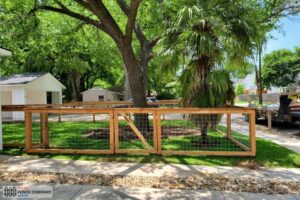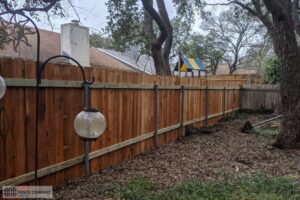Fence Disputes & Neighbor Etiquette in Austin (Non-Legal Guide)
TL;DR
 Fence disputes in Austin are more common than many homeowners realize, and they usually come down to three key issues: property boundaries, fence height and style, and questions of cost or maintenance. The best way to avoid tension with a neighbor is to start with the facts—confirm the exact property line using a recent survey before any work begins. Next, have an open conversation about fence height and design, keeping in mind “good-neighbor” options like double-sided or shadowbox styles that look attractive from both sides. It’s also wise to put cost-sharing and long-term maintenance agreements in writing to avoid confusion later on.
Fence disputes in Austin are more common than many homeowners realize, and they usually come down to three key issues: property boundaries, fence height and style, and questions of cost or maintenance. The best way to avoid tension with a neighbor is to start with the facts—confirm the exact property line using a recent survey before any work begins. Next, have an open conversation about fence height and design, keeping in mind “good-neighbor” options like double-sided or shadowbox styles that look attractive from both sides. It’s also wise to put cost-sharing and long-term maintenance agreements in writing to avoid confusion later on.
In Central Texas, building correctly is just as important as agreeing on the details. Expansive clay soils, limestone shelves, and steep greenbelt slopes can all impact the durability of a fence. A fence that isn’t engineered for local conditions may shift over time, creating new disputes if it drifts into a neighbor’s yard. If disagreements still arise, document all communications, suggest practical compromises such as step-downs, view-friendly sections, or stain color adjustments, and—only after those efforts—seek HOA input or a city code ruling. Often, a timely repair is the simplest peacekeeping step; however, when boundaries or heights are being redefined, a complete replacement under an explicit agreement is the best solution. For expert help navigating these challenges, trust Atlas Fence Company—your local fence company in Austin, committed to building fences that last and keeping neighborly relations strong.
Table of Contents
ToggleWhy fence disputes happen in Austin
Different maps, different memories. One owner has a decade-old survey, the other has a closing plat—neither shows the latest corner pin. Landscaping, retaining stones, and expansive clay movement can cause shifts in perceived lines over time.
Height and style expectations. Austin’s neighborhoods vary: a 6-foot privacy fence is standard in many subdivisions, while lots near greenbelts or view corridors (e.g., Lakeway, Westlake) favor ornamental steel or shorter sight-friendly runs. Without a conversation up front, one side may feel boxed in or exposed.
Maintenance fatigue. Who replaces broken pickets? Who pays to re-stain? Small chores become big sore points when left unclear.
Topography & geology. From Blackland clay east of MoPac to thin clay over limestone shelves out west, soil/rock drives post depth and step-downs. A fence that wasn’t built for the site can tilt, heave, or trespass—sparking blame.
Property lines 101: surveys, pins, and practical locating
Start with documents you already have. Closing packets often include a survey sketch. Look for iron pins (rebar) at corners; they may be buried a few inches deep: a metal detector and a flat shovel help. If pins are missing, a licensed surveyor can reset them.
Don’t build “by the old fence.” Many legacy lines creep over the years. The most neighborly move is to build on the true line (or wholly on your side with a slight offset), not where the tired fence happened to land.
Mind easements and setbacks. Utility, drainage, and greenbelt easements are everyday around Austin. These don’t always block fences, but they can restrict placement, height, and gate openings. For a deeper overview, see your guide on Austin fence regulations & HOA rules (heights, sight triangles, materials, and typical approvals)—it’s the best primer to align expectations before money is spent.
→ Relevant blog: Fence Regulations & HOA Rules (Austin)
Pro move: When a shared boundary is contentious, propose a short “line-walk” with the survey in hand. Mark the proposed post centers with flags; it’s much easier to agree when both parties can see the plan on the ground.
Heights, styles, and the “good-neighbor” look

Heights that feel fair. Six feet is the norm for back/side yards in many Austin subdivisions; step-ups to 7–8 ft are standard where lots terrace or back to busy roads. On view lots, consider lower height segments or a transition to flat-top ornamental steel to protect sightlines.
Good-neighbor designs. Double-sided board-on-board or shadowbox keeps the finished face on both sides—no one stares at rails if you’re mixing styles (e.g., privacy on the patio side; open steel along a view), use clean transitions at posts with a cap/trim detail so it looks intentional.
Stain & color. Medium browns handle the Austin sun well; discuss color before you buy gallons. Agree on a re-stain interval (often every 2–3 years) so both sides age together.
Gates & lines of travel. Gates that swing over a neighbor’s mowing strip are a classic flashpoint. Plan gate swings on your side and keep 2–3 in. of clearance above grade to avoid scraping shared areas.
Who pays? Cost-sharing, ownership & maintenance
Ownership clarity reduces conflict. If you build entirely on the line with a good-neighbor design, co-ownership (and shared upkeep) can make sense—but only if you write it down. If you offset fully onto your parcel, you own it and control maintenance and style.
Cost-sharing norms. In practice, neighbors often split 50/50 when both benefit from privacy/security. When one side wants premium materials (e.g., cedar cap & trim, taller sections), a split with add-on is fair: base cost shared; upgrades paid by the requesting party.
Maintenance. Spell out who re-stains and when, how to handle storm damage, and whether pets/dogs on either side require additional rot boards or barrier mesh.
Paper saves friendships. Keep it friendly but formal: a one-page memo with line location, height, style, stain color, hardware, and who pays what—both signatures.
Repair vs. Replacement: Which Resolves Conflict Faster?
Repair to de-escalate. If the dispute began with a leaning panel, dog escape, or broken gate, a professional repair is often the fastest way to cool tempers and buy time to plan a larger project. For quick, clean fixes that respect the existing line, schedule fence repair in Austin and let a tech stabilize posts, replace damaged pickets, and re-hang the gate without changing the boundary.
Replace to reset. When the fence is nearing the end of its life or the line/height/style needs a rethink, replacement under a clear, shared plan resolves the root issues and stops the cycle of patchwork arguments. If you’re starting fresh (or moving the fence entirely onto your side), bring in a pro for layout, heights, step-downs, and footing details that fit local soils and slopes. Here’s where fence installation in Austin shines—survey-aligned layouts, permits/HOA packages, and neighbor-safe build sequencing.
Austin Field Notes: Soils, Slopes, HOAs & wildlife.
Expansive clay (East/North Austin, Pflugerville/Round Rock). Clay swells when wet, shrinks in drought—heaving posts out of plumb. Use gravel beds under posts and crowned concrete collars to shed water away from the ground line. This keeps the fence from creeping toward a neighbor’s yard.
Thin clay over limestone (Lakeway, Steiner Ranch, Westlake). Shallow digs tempt short embeds; don’t—Core-drill and set posts with non-shrink grout/epoxy where rock is close to grade. Step-downs should follow the slope in clean, even increments so neither side inherits awkward heights.
Greenbelts & drainage. Fences along Barton Creek or neighborhood greenbelts should respect drainage paths—leave weep gaps where appropriate and avoid damming runoff into a neighbor’s lawn. Consider open steel along view corridors with privacy infill only where needed.
HOAs & architectural control committees. Most want consistency: height caps, approved stains, top profiles, and sometimes “good-neighbor” faces along streets. Even if you build wholly on your side, an HOA may still approve materials and height. Bring your neighbor to the ACC review—it builds alignment.
Pets & wildlife. Discuss dig-protection (rot boards, buried wire) and deer-friendly transitions where yards meet greenbelt. These details prevent later “your dog got out” or “deer trashed my garden” disputes.
Crew etiquette. Let neighbors know the install window, where materials will be staged, and how access will work (no walking through their garden beds, please). When we build, we set daily cleanup expectations and a single point of contact so minor issues don’t snowball.
Step-by-step plan to resolve a dispute

- Pull documents. Find your latest survey; print it. If pins are in doubt, schedule a surveyor.
- Draft a one-page plan. Height, style, stain, line location, gates, and rough schedule.
- Walk the line together. Flag corners and key step-downs. Take photos of the agreed marks.
- Agree on cost-share. Base vs. upgrades; stain cycle; maintenance tasks. Please put it in writing.
- Get approvals. HOA/ACC if required; verify any city restrictions that apply to your lot scenario (easements, sight triangles, greenbelts). For a quick refresher, align with your primer on Austin fence regulations & HOA rules linked above.
- Book the work. If repairing, schedule repair first to stabilize hazards; if replacing, sequence removal/install to keep pets secure.
- Do a final walkthrough together. Confirm line, heights, gate swings, and cleanup before crews leave.
- Keep a maintenance calendar. Re-stain on a shared interval; check posts after major storms.
FAQs
Can I build the entire fence on my side and decide everything?
Yes—if you offset fully onto your parcel and pay for it, you control style and maintenance. Still, it’s bright (and neighborly) to discuss the plan in advance, especially if the new fence is taller or visually different.
Who gets the “good side”?
With board-on-board or shadowbox, both sides look finished. If using a one-sided style, many HOAs prefer the finished face to the street. On shared lines, agree in writing which face goes where before ordering materials.
The old fence was 6 ft. Can I go to 8 ft?
Maybe—depending on lot type, sight lines, and HOA rules. Taller fences may require approvals and step-downs at front setbacks or across steep grades. Align on the need (noise, pets, privacy) and propose step-ups only where justified.
My neighbor refuses to participate—now what?
You can replace wholly on your property, or repair failing sections to remove hazards while you plan. Keep communications polite and documented. If the dispute is about the actual boundary, a licensed survey is the quickest path to clarity.
Who handles trees and roots on the line?
Discuss early. In many cases, roots can be accommodated with post spacing tweaks, steel frames, or a slight offset rather than cutting aggressively. Document any agreed-upon trimming or arborist work.
Working with a pro keeps projects friendly.
Clear lines, clean designs, and the proper footings turn an argument into a win-win. If you want a neutral, Austin-savvy partner to layout heights, step-downs, and neighbor-friendly details—and to manage a tidy jobsite—loop in the team at Atlas Fence Company. We’ll help you navigate surveys, HOAs, and soil/rock realities so both sides end up happy. Ready to move from disagreement to done? Get a clear, written scope, a neighbor-calm design, and a schedule that respects both yards. Request a free fence estimate →
